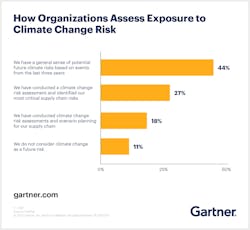In a recent survey from Gartner, conducted from December 2021 to January 2022, it was found that 27% of supply chain leaders have conducted a climate change risk assessment to identify their most critical supply chain risks.
"The effects of climate change are hard to predict, but it is possible to model the risks and opportunities that might occur,” said Heather Wheatley, senior director analyst with the Gartner Supply Chain practice, in a statement. “Chief supply chain officers (CSCOs) regularly assess various risks and opportunities as part of normal business – this must be done for climate change as well.”
According to the survey, 44% of respondents have a general sense of potential climate change risks based on previous events. This means they understand that climate change risks are materializing, but those risks are not methodically identified or quantified. However, the past is not a good predictor of future climate change events, as the severity and impact of events will escalate.
“Scenario planning is a crucial part of the process, as it highlights key elements of a possible future and helps draw attention to the key factors that will drive future developments. For example, in a future that includes raw material scarcity and trade uncertainty, organizations that rely on more resilient inputs such as drought resistant crops can gain a competitive advantage,” Wheatley said.
Lack of Foresight and Long-Term Decision Making
Climate adaptation must be included in investment decisions. For example, if building a new manufacturing plant, design considerations should be made for future climate change threats such as heat waves or water shortages. However, the need for financial investment can deter action. The top barriers to planning for climate change in the supply chain include a focus on short-term decision making (57%) and an inability to link the cause and investment to benefits (57%).
“Investments in climate adaptation require a certain level of foresight. An increasingly popular tool is the shadow carbon price, which applies a notional cost to greenhouse gas emissions, effectively translating a future risk into a present-day operational cost that attracts the attention of business leaders,” Wheatley said.
Only 19% of surveyed companies are using digital technology to help understand climate change risks. Of those organizations that are using technology, 85% are utilizing predictive analysis. Examples of tools that could be used include geospatial analysis, drones and artificial intelligence (AI) capabilities such as ecological simulations. Many organizations are also partnering with external consultants to help model scenarios.
“For those organizations that are not using digital technology, it is unclear what information is being used to help model scenarios and to identify and assess risks. CSCOs should ensure that this blind spot is not overlooked,” Wheatley concluded.




